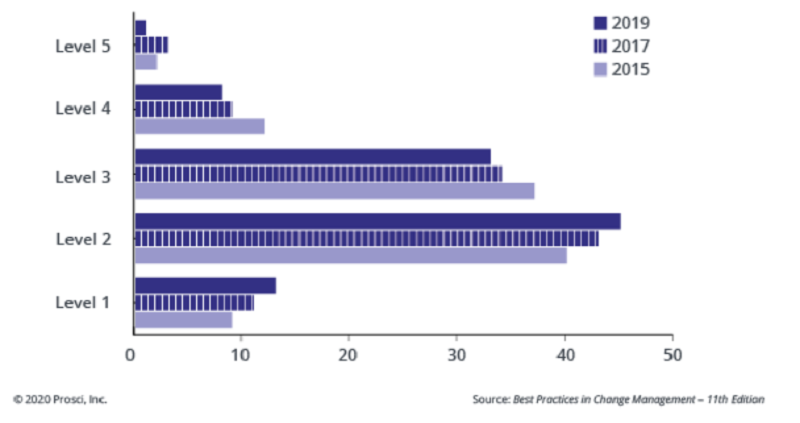(Prosci's Maturity Model - More Detail On Each Level Cont. 1)
Level 3 - change management in multiple projects (some characteristics of organisations at this level:
"...- multiple projects are using structured change management processes, although these approaches and methodologies maybe different
- some elements of knowledge sharing emerge between teams in the organisation: teams in some departments are sharing experiences and lessons learnt
- while change management is applied more frequently, no organisational standards for requirements exist; pockets of excellence in change management coexist with projects that use no change management
- senior leadership takes on a more active role in sponsoring change and considers this role part of their responsibilities, but no formal company-wide programme exists to train project leaders, people managers or coaches on change management
- training and tools become available to the project teams and team members; people managers now have the training and tools to coach front-line employees..."
Prosci, 2023h
While most organisations are still using change management as a reaction to employee resistance during implementation; some organisations are integrating change management (including communications) at the start of some projects.
NB how to progress from level 3 to 4:
"...- enlist executive support from applying change management on every project and for building change competencies at every level in the organisation.
- select a common methodology that can be used throughout the organisation then begin acquiring the tools and training necessary to roll out a common methodology..."
Prosci, 2023h
Level 4 - organisational change management standards (organisation selects common approach and implementation standards for every new change project initiative;
"...A common methodology does not mean one-size-fits-all; effective methodologies use repeatable steps, but they work best when tailored to the specific needs of every project..."
Prosci, 2023h
Some characteristics of organisations at this level:
"...- there is an enterprise-wide acknowledgement of what change management is and why it is important to project success
- they have selected a common change methodology and are developing plans for introducing methodology into the organisation
- executives, project teams and change leaders have access to training and tools, and people managers have formal training on their roles in change management
- there are individuals, groups or administrative positions dedicated to supporting change management efforts and building change management skills
- executives assume the role of change sponsors on every new project and are active and visible sponsors of change
- teams expect resistance and non-compliance in isolated instances, although some project teams may still not understand why they are using change management
- adoption is not yet at 100% and the organisation is in the process of building change management skills throughout the organisation..."
Prosci, 2023h
NB More projects are integrating change management at the beginning of their projects, ie change management included in the all phases of project, starting with planning, etc; teams have both project and change management milestones.
NB How to progress from level 4 to 5
"...- create a formal position in the staff group that is responsible for the effective deployment, training and improvement of change management competencies
- correct non-compliance and analyse gaps in the organisation that are not applying the selected methodology..."
Prosci, 2023h
Level 5 - organisational competency (change management competency is part of the organisational skill set; some characteristics of organisations at this level:
"...- effective management of change is an explicitly stated strategic goal, and executives have made this a priority
- employees across the enterprise understand change management, why it is important to project success, and how they play a role in making change successful
- change management is second nature, so commonplace that it is inseparable from initiatives
- people managers routinely use change management techniques to support a broad range of initiatives, from strategy changes to individual employment improvements
- the organisation gathers data to enable continuous improvements to the common management methodology, tools and training
- extensive training exists at all levels of the organisation
- higher ROI, lower productivity loss, and less employee resistance to change across the organisation..."
Prosci, 2023h
NB change management and project management are fully integrated; with change management being incorporated at the start of the project
Research has shown the percentage of organisations at each level, ie with over half at levels 1 or 2

(source: Prosci, 2023h)
